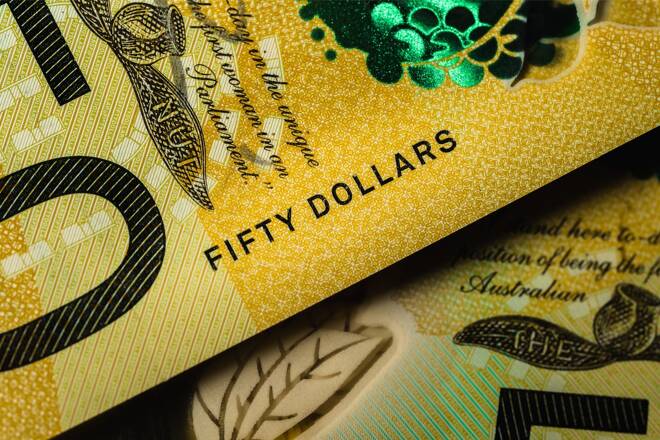Advertisement
Advertisement
AUD/USD Daily Forecast: Trade Terms and US PMI to Drive Aussie Dollar
By:
Key Points:
- Net export contributions to GDP in Q2 2024 may boost AUD/USD, indicating a stronger Aussie economy and rising demand.
- Positive trade terms could lead to job creation, wage growth, and higher consumer spending, fueling AUD/USD gains.
- US manufacturing PMI and Australian trade data are key drivers for AUD/USD, with a focus on narrowing rate differentials.
In this article:
Australian Trade Terms in Focus
On Tuesday, September 3, net export contributions to GDP will spotlight the AUD/USD and the Aussie economy.
Economists expect net export contribution to GDP of 0.3% in Q2 2024 after -0.9% in Q1 2024.
A positive contribution to GDP could boost Aussie dollar demand and indicate an improving demand environment. Australia has a trade-to-GDP ratio of over 50%, with 20% of its workforce in trade-related jobs.
Better trade terms could lead to job creation, wage growth, and increased consumer spending. Rising consumer spending may fuel demand-driven inflation, possibly supporting a higher-for-longer RBA rate path.
Higher-than-expected numbers could suggest an AUD/USD move toward $0.68 as investors await Q2 GDP numbers out on Wednesday, September 4.
Expert Views on the Australian Economy
Judo Bank Chief Economic Advisor Warren Hogan commented on Monday’s Manufacturing PMI survey, stating,
“New orders and output remain soft at readings below 50.0, while employment rose above 50 to signal an expansion in the demand for labour in manufacturing. The good news is that conditions in the manufacturing sector are not deteriorating, although a genuine recovery remains elusive.”
US Economic Calendar
Later in the session on Tuesday, the US manufacturing sector will be in focus. Economists forecast the ISM Manufacturing PMI to increase from 46.8 in July to 47.8 in August.
A higher-than-expected PMI may reinforce expectations of a soft US landing. However, the PMI numbers are unlikely to influence the Fed rate path, as manufacturing contributes less than 30% to US GDP.
Beyond the numbers, investors should continue monitoring comments from FOMC members. Recent economic indicators have reduced bets on a 50-basis point September Fed rate hike. Views on the US economy, inflation, the labor market, and the Fed rate path require consideration.
Weaker-than-expected manufacturing PMI numbers and FOMC member support for a 50-basis point Fed rate cut could push the AUD/USD towards $0.68.
According to the CME FedWatch Tool, the probability of a 50-basis point Fed rate cut fell from 36.4% on August 23 to 32.0% on September 2.
Expert Views on the Fed Rate Path
Shane Oliver, Head of Investment Strategy and Chief Economist at AMP, remarked on Friday’s inflation numbers, stating,
“US Jul core PCE deflator slightly softer at 0.16%mom/2.6%yoy (mkt +0.2%m/+2.7%y), from 2.6%y in Jun PCE deflator in line at 0.2%m/2.5%y. Leaves Fed on track to cut in Sep, which in absence of much weaker jobs looks like being -0.25%.”
On Friday, August 6, the US Jobs Report could dictate the Fed’s September interest rate decision.
Short-Term Forecast: Bullish
Near-term AUD/USD trends will hinge on the trade data from Australia and the US manufacturing sector data. Improving Australian trade terms could drive Aussie dollar demand. Conversely, softer-than-expected US PMI numbers could support a more dovish Fed rate path. The combination may signal a narrower interest rate differential, suggesting an AUD/USD move toward $0.68.
Investors should stay alert to economic data and central bank commentary that may influence AUD/USD price trends. Monitor the real-time data, news updates, and expert commentary to adjust your trading strategies.
Stay updated with our latest views and analysis to manage exposures to the forex markets.
AUD/USD Price Action
Daily Chart
The AUD/USD remained comfortably above the 50-day and 200-day EMAs, affirming the bullish price trend.
A breakout from the $0.67967 resistance level could signal a move to $0.68500. Furthermore, a break above $0.68500 may bring the $0.68996 resistance level into play.
Investors should consider the trade data from Australia, US PMI numbers, and central bank commentary.
Conversely, a fall through the $0.67500 level could give the bears a run at the $0.67003 support level.
With a 14-period Daily RSI reading of 62.41, the Aussie dollar could return to $0.68500 before entering overbought territory.
About the Author
Bob Masonauthor
With over 20 years of experience in the finance industry, Bob has been managing regional teams across Europe and Asia and focusing on analytics across both corporate and financial institutions. Currently he is covering developments relating to the financial markets, including currencies, commodities, alternative asset classes, and global equities.
Latest news and analysis
Advertisement
